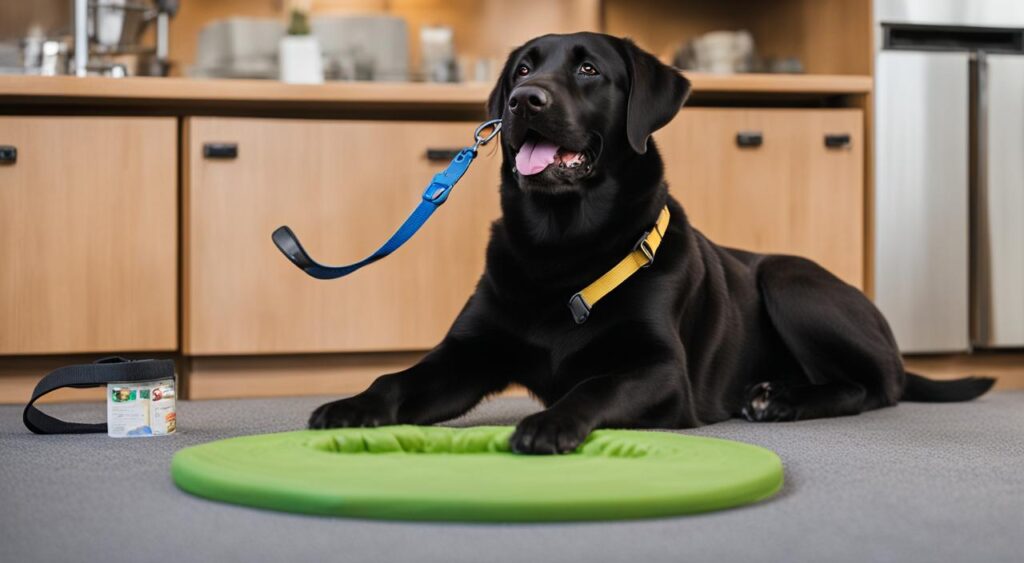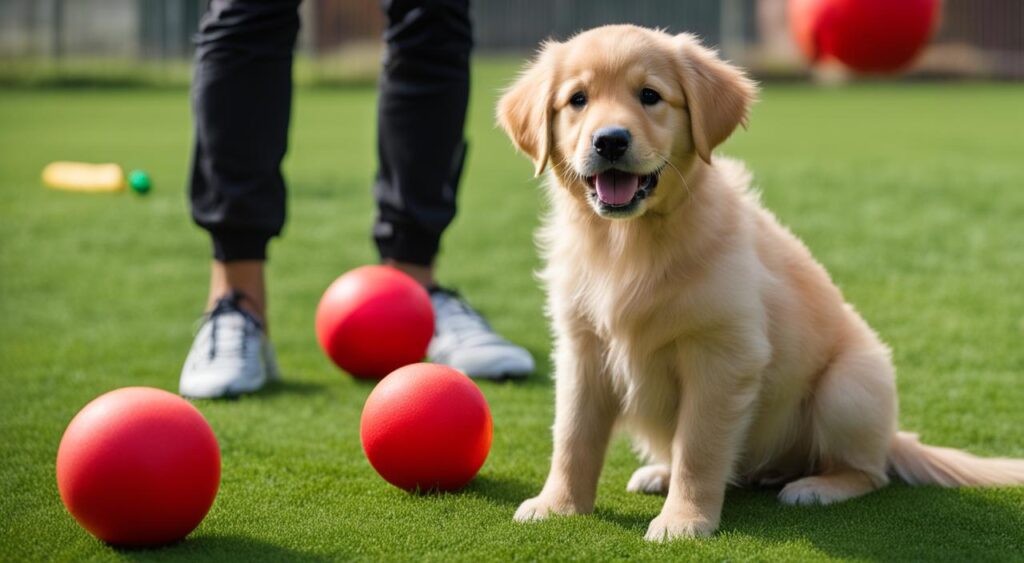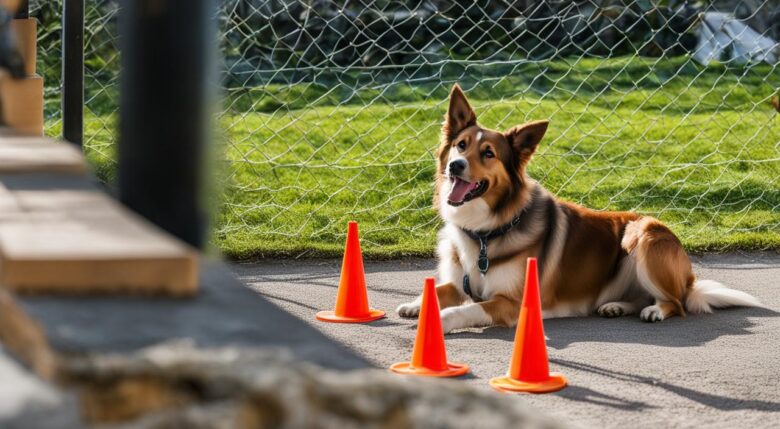If you’re a dog owner, you know that having a canine companion comes with many joys and challenges. One of the biggest hurdles can be training your dog to have good behavior. That’s why in this article, we’ll be exploring essential dog obedience training tips to help you master your dog’s mannerisms and behaviors. Whether you’re a first-time owner or an experienced one looking to enhance your furry friend’s obedience, these techniques will guide you on the path to success.
Key Takeaways:
- Dog obedience training is essential for responsible dog ownership.
- Patience, consistency, and positive reinforcement are key to training success.
- Training techniques will vary depending on the specific behavioral challenge or age of the dog.
- Professional dog training may be necessary for more complex behaviors.
- Establishing a strong foundation and building a trusting relationship with your dog are fundamental to obedience training.
Understanding the Importance of Dog Obedience Training
Dog obedience training is an essential aspect of responsible pet ownership. By investing time and effort in your dog’s training, you can develop a strong foundation of good behavior and improve your bond with your furry friend.
Canine obedience training is not just about teaching your dog to sit, stay, and come when called. It also involves managing and modifying behavior, fostering socialization, and establishing clear communication between you and your dog. These aspects are crucial for developing a well-behaved, happy, and healthy companion.
Some of the benefits of dog obedience training include:
- Improved communication: Training your dog to understand your commands and respond to them promptly can prevent misunderstandings and improve your overall communication.
- A stronger bond: Spending time training your dog can build trust and enhance your relationship with them.
- A trustworthy and well-behaved companion: A well-trained dog is more predictable and less likely to exhibit problematic behaviors such as aggression, excessive barking, or destructive chewing.
Choosing the best dog training methods is crucial for achieving success. Positive reinforcement is a proven training technique that involves rewarding desirable behavior instead of punishing undesirable behavior. This method has been embraced by professional dog trainers and owners alike as a humane and effective approach to training.
Getting Started with Basic Obedience Commands
Every dog needs to learn basic obedience commands to develop good manners and be safe around humans and other animals. These commands help dogs understand their role in the family pack and respond to their owner’s commands. Here are some foundational commands:
- Sit: Start by holding a treat above their head, then slowly move the treat backward over their head. The dog’s natural response will be to sit, and once they do, reward them with the treat.
- Stay: Begin with getting your dog to sit. Maintain eye contact and put your hand up in front of their nose like a stop sign. Say the command “stay” while taking a step back. If they stay put, reward them with praise and a treat. If not, start again.
- Come: Say the command “come” while clapping your hands, motioning the dog to come to you. When they do, give them a treat. For safety purposes, ensure your dog has an identification tag and is microchipped.
- Heel: Hold a treat next to your leg and walk forward while saying the command “heel.” When the dog walks beside you without pulling, reward them with a treat. Repeat this process, gradually increasing the distance and duration of the walk.
Training a dog requires patience, repetition, and positive reinforcement. Focus on rewarding good behavior, rather than punishing bad behavior. Dogs want to please their owners, and with proper training, they can be well-behaved and obedient companions.

Training Techniques for Specific Behavioral Challenges
Despite our best efforts, there may come a time when our beloved pets exhibit behavioral challenges that require specialized training techniques. Here are some common issues and effective ways to address them:
Excessive Barking
Barking is a natural expression of communication for dogs. However, excessive barking can become a nuisance. To address this behavior, it’s vital to understand why your dog is barking excessively. Once you identify the cause, you can begin to train your dog to control their barking effectively. Use positive reinforcement by rewarding silence and taking your dog’s attention away from what triggers their barking. You may also incorporate a “quiet” command and gradually increase the duration.
Jumping
Jumping is a common behavior in dogs, particularly when they greet people. While it may appear playful, it can cause problems and be dangerous, especially for children and elderly individuals. To address jumping, it’s essential to teach your dog alternate forms of greeting and reward them for calmer behavior. Use positive reinforcement for sitting or standing calmly on all four paws and redirect your dog’s energy with a toy or treat.
Separation Anxiety
Separation anxiety is a common, but distressing behavior in dogs and is often displayed when owners leave for an extended period. Dogs with separation anxiety often display destructive behavior, attempt to escape, or may vocalize excessively. To address this behavior, implement measures that help your dog cope with your absence, such as leaving a piece of clothing with your scent or incorporating a special toy or treat reserved for when you’re away. Gradually create positive associations with your departure and return, and allow your dog to learn independence and security without you.
Addressing specific behavioral challenges in dogs requires patience, perseverance, and dedication. While these techniques can be effective, it’s always best to seek the advice of a professional dog trainer for complex issues. With the right approach and consistent training, you can overcome behavioral challenges and strengthen the bond between you and your furry friend.
Puppy Obedience Training: Building a Strong Foundation
Puppies are adorable but bring a set of responsibilities. A well-trained puppy will become a well-behaved adult dog. Puppy obedience training is crucial in establishing this behavior from a young age. The best dog training methods involve a combination of socialization, house training, and bite inhibition techniques.
“Socialization is the process of exposing your puppy to different people, dogs, and environments to develop a confident and friendly adult dog,”
according to Smith & Wesson, highly regarded experts in canine obedience training.
Building a strong foundation takes time, effort, and patience. House-training, crate-training, and leash-training are all essential components of building a strong foundation.

The table below provides a summary of the best dog training methods for puppy obedience:
| Best Dog Training Methods for Puppy Obedience | Techniques |
|---|---|
| Socialization | Expose your puppy to different people, dogs, and environments to develop a confident and friendly adult dog. |
| House-training | Establish a routine and reward system, supervise your puppy, and clean up any accidents immediately. |
| Bite Inhibition | Teach your puppy how to control the strength of their bite and prevent any aggressive behaviors. |
By implementing these puppy obedience training techniques from the beginning, you can establish a solid foundation of obedience, and develop better communication with your furry friend.
Advanced Obedience Training: Taking it to the Next Level
As your furry friend masters basic obedience commands, you can transition to advanced training methods that will challenge your dog’s skills and strengthen your bond. Professional dog training and dog behavior training are essential to unlock these advanced techniques.
Off-leash training is one of the most challenging yet rewarding experiences for dog owners and their pets. It allows you to build a stronger connection with your dog, as you encourage them to respond to your commands while off-leash. However, it’s vital to master basic obedience skills before attempting this type of training.
Advanced commands are another component of advanced obedience training. These commands go beyond the basics and require more focus and concentration from your dog. Examples include targeting, identifying objects, and performing tricks. These types of commands not only strengthen obedience but also build your dog’s confidence and mental acuity.
When addressing complex behaviors, consider consulting with a professional dog trainer. Issues such as separation anxiety, aggression, and fear are more challenging to correct and require specialized techniques. A professional dog trainer can help you develop a plan tailored to your dog’s specific needs.
“Advanced obedience training takes patience, time, and effort. By prioritizing professional dog training and dog behavior training, you can unlock your dog’s true potential and build a remarkable relationship.”
Avoid These Mistakes in Advanced Obedience Training
| Mistake | How to Avoid It |
|---|---|
| Skipping basic obedience training | Ensure your dog has mastered basic obedience skills before beginning advanced training methods |
| Neglecting positive reinforcement | Always use positive reinforcement techniques to encourage your dog’s progress and success |
| Pushing your dog too hard | Be patient and avoid overwhelming your dog with advanced commands or techniques they’re not prepared for |
| Ignoring your dog’s individual learning style | Pay attention to what training methods work best for your dog and tailor your approach accordingly |
With the right approach and mindset, advanced obedience training can transform your dog into a well-behaved, highly trained companion. Don’t shy away from professional dog training and dog behavior training, as they can guide you and your dog on a fulfilling journey to success.
Addressing Behavioral Issues: Tips and Strategies
While most dogs respond well to obedience training, some may exhibit specific behavior problems that require targeted training and management. Understanding the underlying causes of these issues is crucial for developing effective strategies. Here are some practical tips and strategies to address common dog behavior problems:
Aggression
Aggressive behavior in dogs can be a serious problem, making it important to address this issue early on. Consult a professional dog behaviorist if your dog displays aggressive tendencies, as their expertise can help you develop a customized training plan. In the meantime, it’s essential to keep your dog muzzled and on a leash when outside and avoid exposing them to situations that may trigger aggressive behavior.
Fear
Some dogs may exhibit fearful behavior, which can be caused by a variety of factors, including lack of socialization or traumatic experiences. Gradual desensitization and counter-conditioning can help reduce fear in dogs. Use positive reinforcement techniques to reward calm and confident behavior, and avoid punishing your dog for being scared.
Excessive Chewing
Excessive chewing is a common behavior problem in dogs, and it can be caused by boredom, stress, or a lack of attention. Providing plenty of chew toys and interactive puzzles can help keep your dog mentally stimulated and reduce destructive behavior. Avoid leaving your dog alone for long periods and consider hiring a dog walker to provide additional exercise and attention.
“Proper training can transform a pet into a loyal and trusted companion.”
Remember that behavior problems in dogs can be challenging to address, and it’s crucial to seek professional help if needed. Professional canine obedience training can provide you and your dog with the skills and knowledge necessary to live a happy and harmonious life together.
Conclusion
In conclusion, dog obedience training is an essential aspect of responsible dog ownership. It not only helps to keep your furry friend safe but also strengthens your bond with them and improves their overall behavior. By following the tips and techniques provided in this article, you can master good behavior in your canine companion, whether you’re a first-time dog owner or have years of experience. Remember, patience, consistency, and positive reinforcement are key to success.
FAQ
What is dog obedience training?
Dog obedience training refers to the process of teaching dogs to respond to specific commands, follow instructions, and exhibit good behavior. This training helps dogs understand their role in the family, enhances communication, and establishes a harmonious relationship between dogs and their owners.
Why is dog obedience training important?
Dog obedience training is important for several reasons. It promotes good behavior, reduces behavioral issues, and ensures the safety of both the dog and the people around them. This training enhances the bond between dogs and their owners, improves communication, and makes day-to-day interactions more enjoyable.
How can I train my dog?
To train your dog, you can use various techniques such as positive reinforcement, repetition, and consistency. Start with basic obedience commands like sit, stay, and come, gradually progressing to more advanced commands. It’s important to use rewards, praise, and treats to motivate your dog and make the training experience positive and fun.
What are the best dog training methods?
The best dog training methods focus on positive reinforcement, reward-based techniques, and clear communication. Using treats, praise, and rewards, you can motivate your dog to learn and follow commands. Avoid harsh training methods that involve punishment or physical force, as they can damage the trust between you and your dog.
How do I address specific behavioral challenges in my dog?
Addressing specific behavioral challenges in dogs requires understanding the underlying causes and using appropriate training techniques. For issues like excessive barking or jumping, redirection, desensitization, and reward-based training can be effective. In cases of separation anxiety or fear-based behaviors, professional guidance and gradual desensitization techniques may be necessary.
What should I focus on during puppy obedience training?
During puppy obedience training, focus on socialization, house training, and teaching basic commands. Expose your puppy to various environments, people, and other animals to ensure they become well-adjusted adults. Consistency, positive reinforcement, and gentle guidance are key to building a strong foundation of good behavior in your puppy.
How can I take my dog’s training to the next level?
Once your dog has mastered basic obedience commands, you can take their training to the next level by introducing advanced commands, off-leash training, and more challenging tasks. Consider enrolling in professional dog training classes or seeking guidance from experienced trainers to effectively enhance your dog’s skills and behaviors.
What should I do if my dog has behavioral issues?
If your dog has behavioral issues such as aggression, fear, or excessive chewing, it’s essential to address them promptly. Understand the root causes behind these issues and seek professional help if necessary. Implement training techniques that focus on positive reinforcement, consistency, and patience to reshape your dog’s behavior and create a safe and harmonious environment.




